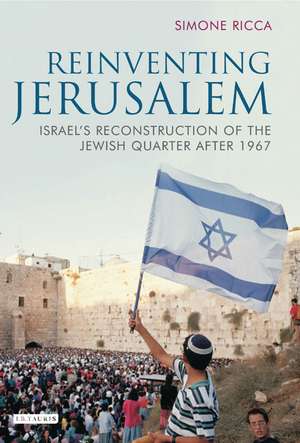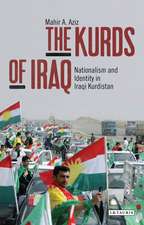Reinventing Jerusalem: Israel's Reconstruction of the Jewish Quarter After 1967
Autor Simone Riccaen Limba Engleză Hardback – 22 mai 2007
Preț: 775.02 lei
Preț vechi: 1113.63 lei
-30% Nou
Puncte Express: 1163
Preț estimativ în valută:
148.30€ • 154.84$ • 122.74£
148.30€ • 154.84$ • 122.74£
Carte disponibilă
Livrare economică 14-28 martie
Preluare comenzi: 021 569.72.76
Specificații
ISBN-13: 9781845113872
ISBN-10: 184511387X
Pagini: 272
Ilustrații: 16 colour in an 8pp plate section
Dimensiuni: 156 x 234 x 27 mm
Greutate: 0.59 kg
Editura: Bloomsbury Publishing
Colecția I.B.Tauris
Locul publicării:London, United Kingdom
ISBN-10: 184511387X
Pagini: 272
Ilustrații: 16 colour in an 8pp plate section
Dimensiuni: 156 x 234 x 27 mm
Greutate: 0.59 kg
Editura: Bloomsbury Publishing
Colecția I.B.Tauris
Locul publicării:London, United Kingdom
Notă biografică
Simone Ricca is an architect who has worked throughout the Middle East on UNESCO heritage and reconstruction projects. He has a PhD in Middle Eastern Studies from the University of Exeter
Cuprins
Preface, p. 2; Introduction, p. 5; Historic Context, p. 20; 1. Planning, Nationalism, Heritage and the Jewish Quarter Reconstruction, p. 34; Zionism, the City and Jerusalem, p. 35; Urban Planning and the Creation of the Jewish Capital, p. 39; Heritage, History and Ideology, p. 44; The New Symbolic Meaning of the 'Restored' Jewish Quarter, p. 48; Conclusion, p. 55; 2. Creating the Jewish Quarter, p. 61; The Legal Framework and the Land Confiscation, p. 62; Israeli Architecture, from Prefabrication to Restoration, p. 71; Israeli Archaeology: an Overview, p. 76; The Jewish Quarter Archaeological Excavations, p. 81; Conclusion, p. 85; 3. Building the Jewish Quarter, p. 92; Guidelines for Reconstruction, p. 93; Analysis of the Urban and Architectural Plans, p. 102; Economical and Social Analysis, p. 111; Conclusion, p. 122; 4. Building the Jewish Quarter: Case Studies, p. 130; Selection of the Case Studies, p. 131; The Hurva Synagogue Restoration, p. 134; The Wailing Wall Area, p. 143; The Cardo Project, p. 148; Conclusion: What's in a name?, p. 155; 5. UNESCO and Jerusalem, p. 160; Introduction, p. 161; The Legal System for the Protection of Cultural Heritage, p. 163; Cultural Heritage, UNESCO Politics and the Case of Jerusalem, p. 168; The Urban Transformations: Technical Data (from the Official Reports), p. 172; Lemaire's Reports and UNESCO Policy for Jerusalem: an Interpretation, p. 181; Conclusion, p. 188; 6. Urban Restoration and Ideology in the Middle East:; A Comparative Approach, p. 196; Introduction: Criteria for the Comparison, p. 197; The Fate of the Jewish Quarters in the Arab World, p. 202; Urban Restoration and Arab Heritage in Israel, p. 212; Urban Conservation in Palestinian National Authority's cities, p. 225; Conclusion: The Role of Ideology, Similarities and Differences, p. 244; Conclusion, p. 256; Bibliography, p. 265.














